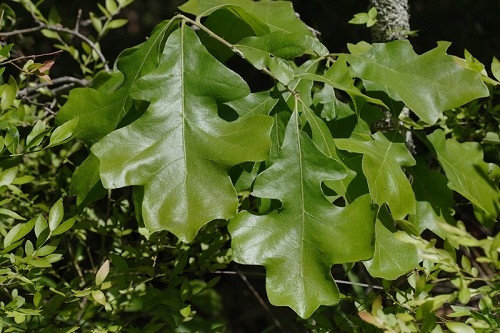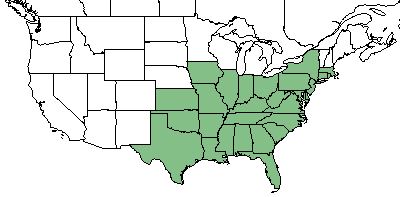Difference between revisions of "Quercus stellata"
(→Conservation and Management) |
|||
| Line 1: | Line 1: | ||
{{italic title}} | {{italic title}} | ||
| + | Common name: post oak <ref name= "Weakley 2015"/> | ||
<!-- Get the taxonomy information from the NRCS Plants database --> | <!-- Get the taxonomy information from the NRCS Plants database --> | ||
{{taxobox | {{taxobox | ||
Revision as of 16:13, 11 June 2018
Common name: post oak [1]
| Quercus stellata | |
|---|---|

| |
| Photo by John Gwaltney hosted at Southeastern Flora.com | |
| Scientific classification | |
| Kingdom: | Plantae |
| Division: | Magnoliophyta - Flowering plants |
| Class: | Magnoliopsida - Dicots |
| Order: | Fagales |
| Family: | Fagaceae |
| Genus: | Quercus |
| Species: | Q. stellata |
| Binomial name | |
| Quercus stellata Wangenheim | |

| |
| Natural range of Quercus stellata from USDA NRCS Plants Database. | |
Contents
Taxonomic Notes
Synonyms: Q. stellata var. stellata; Q. villosa Walter
Varieties: none
Description
Q. stellata is a perennial tree of the Fagaceae family native to North America. [2]
Distribution
Q. stellata is found in the southeastern corner of the United States from Texas to Massachusetts. [2]
Ecology
Habitat
Q. stellata proliferates in uland forests and woodlands, especially in clay or rocky soils and in communities at least formerly exposed to fire. [1]
Phenology
Q. stellata flowers March-May and November. [3]
Fire ecology
Q. stellata is not fire resistant and has medium fire tolerance. [2]
Use by animals
Q. stellata has low palatability for grazing and browsing animals. [2]
Conservation and Management
Q. stellata is listed as a special concern species by the Rhode Island Department of Environmental Management. [2]
Cultivation and restoration
Photo Gallery
References and notes
- ↑ 1.0 1.1 Weakley, A. S. (2015). Flora of the Southern and Mid-Atlantic States. Chapel Hill, NC, University of North Carolina Herbarium.
- ↑ 2.0 2.1 2.2 2.3 2.4 USDA Plant Database https://plants.usda.gov/core/profile?symbol=QUST
- ↑ PanFlora Author: Gil Nelson URL: http://www.gilnelson.com/PanFlora/ Date Accessed: 5/29/18